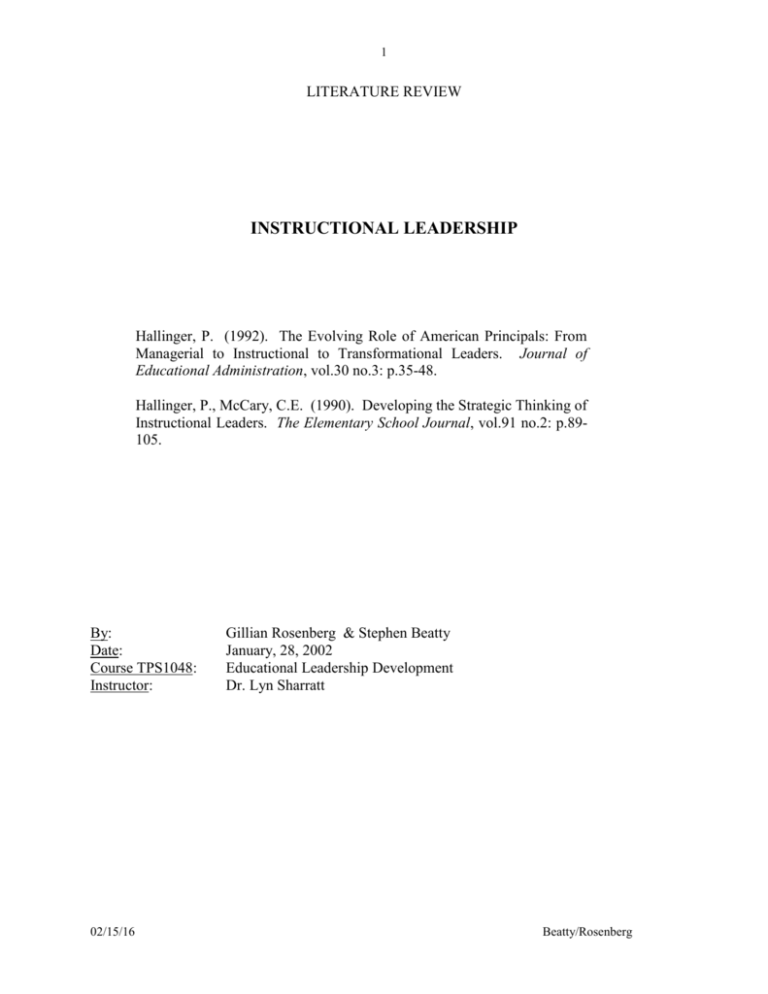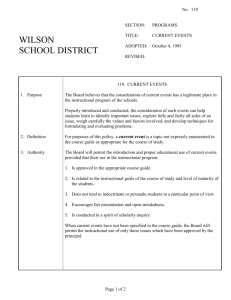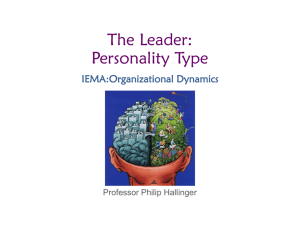here
advertisement

1 LITERATURE REVIEW INSTRUCTIONAL LEADERSHIP Hallinger, P. (1992). The Evolving Role of American Principals: From Managerial to Instructional to Transformational Leaders. Journal of Educational Administration, vol.30 no.3: p.35-48. Hallinger, P., McCary, C.E. (1990). Developing the Strategic Thinking of Instructional Leaders. The Elementary School Journal, vol.91 no.2: p.89105. By: Date: Course TPS1048: Instructor: 02/15/16 Gillian Rosenberg & Stephen Beatty January, 28, 2002 Educational Leadership Development Dr. Lyn Sharratt Beatty/Rosenberg 2 Two journal articles on instructional leadership (Hallinger & McCary, 1990; Hallinger, 1992), along with additional references, have shed much light on the evolution of educational leadership. They trace a journey from the 1960s when managerial forms of leadership prevailed, through the 1980s with instructional leadership, to the 1990s when transformational leadership became vogue. One article in particular (Hallinger, 1992) presents a contextual framework for this evolution, in the form of changing societal expectations of schools and reform agendas. The second article (Hallinger & McCary, 1990) focuses on the cognitive processes that underlie the particular behaviors characteristic of instructional leaders. Together they present a comprehensive perspective of this leadership style and are consistent with much of the literature representing both the United States and Canada. Although the paradigm of instructional leadership is currently falling from grace, its concepts and behaviors dominated North American schools throughout the 1980s (Leithwood, Jantzi & Steinbach, 1999, p.23,26). This was the result of a new school reform agenda, influenced by the Effective Schools Movement. It renewed interest in classroom activities and student achievement. Thus, Principals were expected to become increasingly involved and hands-on in monitoring and supervising curriculum, staff development, pedagogy and student progress (K. Leithwood lecture, January 2002). In addition, Principals were asked to define the school mission and promote a school climate focused on the instructional program (Leithwood, Jantzi & Steinback, 1999, p.8). The prevailing form of managerial leadership from the 1960s and 1970s, with an emphasis on policies and procedures, was inadequate in pursuing this agenda (Leithwood and Duke, 1999, p.65). “Instructional leadership became the new educational standard for principals.” (Hallinger, 1992, p.37). In concept, instructional leadership took hold. In reality however, little changed within the schools as principals continued to emphasize control and coordination of activities, with a top-down orientation (Leithwood, Jantzi & Steinbach, 1999, p.24; Hallinger, 1992, p.38). “Thus, while instructional leadership demanded a new focus and set of work activities from the principal, the role conceived for the principal was still inherently managerial in nature.” (Hallinger, 1992, p.38) Hallinger and McCary blamed this on a lack of real support for change by way of resources and meaningful instruction (1990, p.90). For example, they identified the ability of strategic thinking as being most significant for instructional leaders, yet demonstrated the inadequacy of leadership training in providing opportunities for learning this skill. “Road signs exist, but no maps are yet for sale.” (Cuban in Hallinger, 1992, p.38) The 1990s once again saw a shift in the concept of school reform. Just as instructional leadership was being manifest throughout schools, it too became inadequate in pursuing the new reform agenda of school restructuring (Leithwood, Jantzi & Steinbach, 1999, p.23). No longer was it valuable to have Principals 02/15/16 Beatty/Rosenberg 3 leading from the ‘front’ of the organization, generating goals and imposing them on teachers. No longer were packaged solutions and programs adequate in solving the variety of problems that were emerging. No longer was the Principal thought of as the ultimate authority on educational issues (Hallinger, 1992, p.41-42). “…it has become increasingly difficult to justify instructional leadership images for those in formal leadership roles…indeed that image is now displaying all the signs of a dying paradigm.” (Leithwood, Jantzi & Steinbach, 1999, p.26) Instructional leaders are “ill-suited to long-term needs for institutional development in schools.” (Hallinger, 1992, p.39). Hence, a new leadership style called transformational leadership has already emerged to replace instructional leadership (Hallinger, 1992, p.40). Interestingly, there is evidence of a backlash against the transformational model of leadership and a renaissance of support for the instructional model of the 1980’s. In his 2001 essay, Instructional Leadership and School Improvement, found at http://www.nottingham.ac.uk/education/Hopkins/ilsi.htm, David Hopkins questions the validity of transformational leadership in that it “lacks a specific orientation toward student learning.” The emphasis of leaders on activities which “directly affect the growth of students” is central to the concept of instructional leadership, and it is this focus which attracts Hopkins to the instructional model. Similarly, the September 12, 2001 on-line edition of Education Week (http://www.edweek.org/ew/newstory.cfm?slug=02instruct.h21) reported on the Principals’ Leadership Academy, where instructional leadership, fueled by demands for accountability in the classroom, has been given a renewed focus. In 1994, well beyond the golden age of instructional leadership, The Interstate School Leaders Licensure Consortium (ISLLC) of the United States was founded on a “vision of leadership based on the premise that the criteria and standards for the professional practice of school leaders must be grounded in the knowledge and understanding of teaching and learning.” (http://www.ccsso.org/isllc.html). Experience shows that a post-transformational paradigm of educational leadership is likely to emerge and become the dominant model. As educational leaders continue with the day-to-day running of schools, they are challenged to decide which aspects of the various leadership models are most useful in their current and future practice. In other words, what skills will be carried forward and what will be left behind? While the shift from managerial leadership to instructional leadership was evolutionary, the shift from instructional leadership to transformational leadership is revolutionary, involving radical thinking on all aspects of the organization (Leithwood, Jantzi & Steinbach, 1999, p.24-26; Louis, Toole & Hargreaves, 1999). Nevertheless, the concepts framed within the doctrine of instructional leadership can still provide a useful context within which reflective leaders can govern their practice. 02/15/16 Beatty/Rosenberg 4 REFERENCES Hallinger, P. (1992). The Evolving Role of American Principals: From Managerial to Instructional to Transformational Leaders. Journal of Educational Administration, vol.30 no.3: p.35-48. Hallinger, P., McCary, C.E. (1990). Developing the Strategic Thinking of Instructional Leaders. The Elementary School Journal, vol.91 no.2: p.89-105. Leithwood, K. & Duke, D. (1999). A Century’s Quest to Understand School Leadership. In J. Murphy & K.S. Louis (Eds.), Handbook of Research on Educational Administration, second edition (p.45-72). San Francisco: Jossey-Bass. Leithwood, K., Jantzi, D., & Steinbach, R. (1999). Changing Leadership for Changing Times. Buckingham: Open University Press. Louis, K.S., Toole, J. & Hargreaves, A. (1999). Rethinking School Improvement. In J. Murphy and K.S. Louis (Eds.), Handbook of Research on Educational Administration, second edition (p. 251-276). San Francisco: Jossey-Bass. 02/15/16 Beatty/Rosenberg









